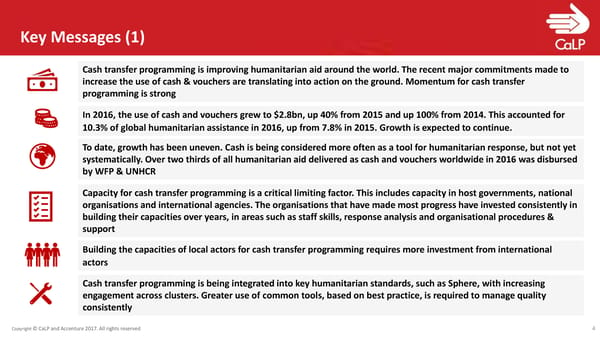Key Messages (1) Cash transfer programming is improving humanitarian aid around the world. The recent major commitments made to increase the use of cash & vouchers are translating into action on the ground. Momentum for cash transfer programming is strong In 2016, the use of cash and vouchers grew to $2.8bn, up 40% from 2015 and up 100% from 2014. This accounted for 10.3% of global humanitarian assistance in 2016, up from 7.8% in 2015. Growth is expected to continue. To date, growth has been uneven. Cash is being considered more often as a tool for humanitarian response, but not yet systematically. Over two thirds of all humanitarian aid delivered as cash and vouchers worldwide in 2016 was disbursed by WFP & UNHCR Capacity for cash transfer programming is a critical limiting factor. This includes capacity in host governments, national organisations and international agencies. The organisations that have made most progress have invested consistently in building their capacities over years, in areas such as staff skills, response analysis and organisational procedures & support Building the capacities of local actors for cash transfer programming requires more investment from international actors Cash transfer programming is being integrated into key humanitarian standards, such as Sphere, with increasing engagement across clusters. Greater use of common tools, based on best practice, is required to manage quality consistently Copyright © CaLPand Accenture 2017. All rights reserved 4
 State of World’s Cash Report | Presentation Page 4 Page 6
State of World’s Cash Report | Presentation Page 4 Page 6